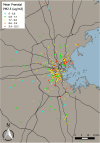Prenatal Exposure to and Cardiac Vagal Tone during Infancy: Findings from a Multiethnic Birth Cohort
- PMID: 31663780
- PMCID: PMC6867319
- DOI: 10.1289/EHP4434
Prenatal Exposure to and Cardiac Vagal Tone during Infancy: Findings from a Multiethnic Birth Cohort
Abstract
Background: The autonomic nervous system plays a key role in maintaining homeostasis and responding to external stimuli. In adults, exposure to fine particulate matter () has been associated with reduced heart rate variability (HRV), an indicator of cardiac autonomic control.
Objectives: Our goal was to investigate the associations of exposure to fine particulate matter () with HRV as an indicator of cardiac autonomic control during early development.
Methods: We studied 237 maternal-infant pairs in a Boston-based birth cohort. We estimated daily residential using satellite data in combination with land-use regression predictors. In infants at 6 months of age, we measured parasympathetic nervous system (PNS) activity using continuous electrocardiogram monitoring during the Repeated Still-Face Paradigm, an experimental protocol designed to elicit autonomic reactivity in response to maternal interaction and disengagement. We used multivariable linear regression to examine average exposure across pregnancy in relation to PNS withdrawal and activation, indexed by changes in respiration-corrected respiratory sinus arrhythmia ()-an established metric of HRV that reflects cardiac vagal tone. We examined interactions with infant sex using cross-product terms.
Results: In adjusted models we found that a 1-unit increase in (in micrograms per cubic meter) was associated with a 3.53% decrease in baseline (95% CI: , 0.02). In models examining change between episodes, higher was generally associated with reduced PNS withdrawal during stress and reduced PNS activation during recovery; however, these associations were not statistically significant. We did not observe a significant interaction between and sex.
Discussion: Prenatal exposure to may disrupt cardiac vagal tone during infancy. Future research is needed to replicate these preliminary findings. https://doi.org/10.1289/EHP4434.
Figures



Similar articles
-
Prenatal particulate air pollution exposure and body composition in urban preschool children: Examining sensitive windows and sex-specific associations.Environ Res. 2017 Oct;158:798-805. doi: 10.1016/j.envres.2017.07.026. Epub 2017 Jul 30. Environ Res. 2017. PMID: 28759881 Free PMC article.
-
Synergistic effects of prenatal exposure to fine particulate matter (PM2.5) and ozone (O3) on the risk of preterm birth: A population-based cohort study.Environ Res. 2019 Sep;176:108549. doi: 10.1016/j.envres.2019.108549. Epub 2019 Jun 19. Environ Res. 2019. PMID: 31252204
-
Associations between prenatal traffic-related air pollution exposure and birth weight: Modification by sex and maternal pre-pregnancy body mass index.Environ Res. 2015 Feb;137:268-277. doi: 10.1016/j.envres.2014.10.035. Epub 2015 Jan 16. Environ Res. 2015. PMID: 25601728 Free PMC article.
-
Maternal fine particulate matter (PM2.5) exposure and adverse birth outcomes: an updated systematic review based on cohort studies.Environ Sci Pollut Res Int. 2019 May;26(14):13963-13983. doi: 10.1007/s11356-019-04644-x. Epub 2019 Mar 20. Environ Sci Pollut Res Int. 2019. PMID: 30891704
-
Impact of ambient PM2.5 on adverse birth outcome and potential molecular mechanism.Ecotoxicol Environ Saf. 2019 Mar;169:248-254. doi: 10.1016/j.ecoenv.2018.10.109. Epub 2018 Nov 16. Ecotoxicol Environ Saf. 2019. PMID: 30453172 Review.
Cited by
-
The impact of social disadvantage on autonomic physiology of latinx adolescents: The role of environmental risks.New Dir Child Adolesc Dev. 2022 Mar;2022(181-182):91-124. doi: 10.1002/cad.20462. Epub 2022 May 30. New Dir Child Adolesc Dev. 2022. PMID: 35634899 Free PMC article.
-
Role of atmospheric particulate matter exposure in COVID-19 and other health risks in human: A review.Environ Res. 2021 Jul;198:111281. doi: 10.1016/j.envres.2021.111281. Epub 2021 May 5. Environ Res. 2021. PMID: 33961825 Free PMC article. Review.
-
Effect of In utero Exposure to Air Pollution on Adulthood Hospitalizations.J Urban Health. 2024 Feb;101(1):92-108. doi: 10.1007/s11524-023-00803-1. Epub 2023 Dec 8. J Urban Health. 2024. PMID: 38064154 Free PMC article. Review.
-
Prenatal Household Air Pollution Exposure and Childhood Blood Pressure in Rural Ghana.Environ Health Perspect. 2024 Mar;132(3):37006. doi: 10.1289/EHP13225. Epub 2024 Mar 20. Environ Health Perspect. 2024. PMID: 38506828 Free PMC article. Clinical Trial.
-
Extending the Environmental influences on Child Health Outcomes (ECHO) Cohort through 2030: Rationale and study protocol.PLoS One. 2024 Dec 26;19(12):e0312677. doi: 10.1371/journal.pone.0312677. eCollection 2024. PLoS One. 2024. PMID: 39724080 Free PMC article.
References
-
- Abboud FM. 2010. The Walter B. Cannon Memorial Award Lecture, 2009. Physiology in perspective: the wisdom of the body. In search of autonomic balance: the good, the bad, and the ugly. Am J Physiol Regul Integr Comp Physiol 298(6):R1449–1467, PMID: 20219871, 10.1152/ajpregu.00130.2010. - DOI - PMC - PubMed
-
- Adamson LB, Frick JE. 2003. The still-face: a history of a shared experimental paradigm. Infancy 4(4):451–473, 10.1207/S15327078IN0404_01. - DOI
Publication types
MeSH terms
Substances
Grants and funding
LinkOut - more resources
Full Text Sources
Medical

